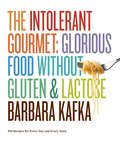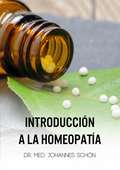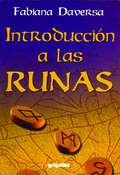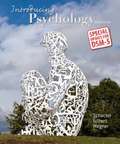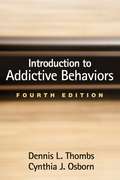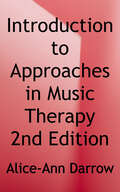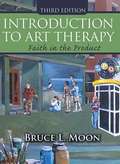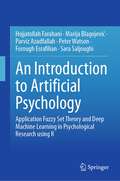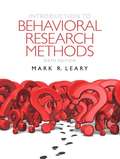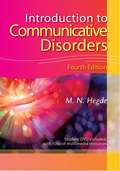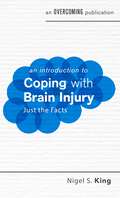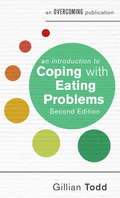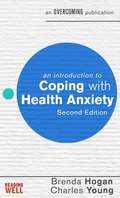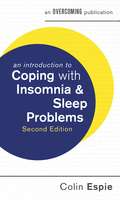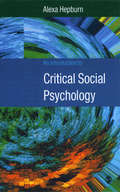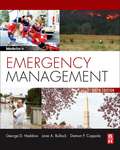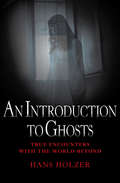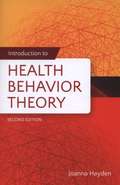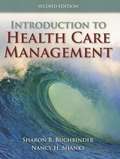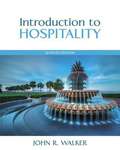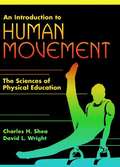- Table View
- List View
The Intolerant Gourmet: Glorious Food without Gluten and Lactose
by Barbara KafkaAt last—a cookbook of pleasure, not compromise, for those with food intolerancesIt’s estimated that nearly 1 in 3 North Americans is lactose-intolerant and that 1 in 133 is gluten-intolerant, although many of these people remain undiagnosed. <P><P>For those who do find out, the resulting dietary adjustments have traditionally been about restriction, denial, and deprivation. All these compromises drain the pleasure from eating. <P>Now, legendary food maven Barbara Kafka comes to the rescue with a complete soup-to-nuts cookbook full of great food that you can enjoy every day. Barbara’s own intolerances, dormant since childhood, returned five years ago, and—as someone who was already intolerant of bad food, ersatz ingredients, and poor cooking—she rose to the challenge of being gluten- and lactose-intolerant with this collection of 300 recipes. <P>They get you to crispy without resorting to breading or flour coatings, offer silkiness and richness without dairy, and feature luxurious textures in sauces and soups without flour or butter. Thanks to the creativity of Barbara Kafka, you can say good-bye to the blandest of diets and indulge in such delights as Chicken with Chervil Sauce, Roasted Salmon with Dill Sauce, Cannellini and Mushroom Soup, Corn Relish, and Asian Noodle Salad. The Intolerant Gourmet contains an enormous range of dishes that fit into many cherished culinary traditions (Asian, French, American, Italian, etc.). <P>Each delicious recipe will satisfy anyone at the dinner table, whether intolerant or not. The book also features tools such as a guide to gluten-free pastas and a comprehensive section on starches—their assets and detriments, the basic methods for preparing them, and the best ways of serving them. <P>All is presented with insight and irrepressible wit (of her Simple Rib Roast, for instance, Barbara writes ,“My roast is rare, but no Saxon pillage”). The result is an indispensable reference tool, ideal for lovers of good food in search of an all-inclusive approach to cooking.
Introducción a la homeopatía
by Dr Johannes Schön¿Cómo funciona la homeopatía y cómo podemos utilizar los principios de la homeopatía en la práctica? En este libro encontrará una introducción fácilmente entendible a la fascinante forma de actuar de la homeopatía.
Introducción a las runas
by Fabiana DaversaIntroducción a las runas, es un libro-manual excelente para acercarnos aeste mundo mágico de las runas. INTRODUCCION A LAS RUNASAquellos que deseen iniciarse en el mundo mágico de las runas hallaránen este libro un texto claro, directo y fundamental que sentará lasbases para un largo desarrollo. La concepción de Introducción a lasrunas se remonta a los primeros contactos de la propia autora con laexperiencia rúnica, y este libro mantiene la frescura de quien se acercaa ese imaginario por primera vez. Expresa, de forma natural y sencilla,la impresión de un mundo simbólico nuevo. Por eso, también aquellos queya conocen a Fabiana Daversa y su obra encontrarán aquí una nueva puertade entrada para comprender e interpretar mejor este sistemaextraordinario.Un texto capaz de promocionar a todos los lectores un conocimientopreciso y profundo del tema.
Introducing Psychology With Updates On DSM-5
by Daniel L. Schacter Daniel T. Gilbert Daniel M. WegnerA great read is just the beginning. . . Instructor and student evaluations from coast to coast attest to the Dans' captivating writing These award-winning bestselling authors know how to enthrall students with the subject they love best--psychology But in the new edition of Introducing Psychology, they go even further to ensure that students won't commit one of the seven sins of memory--forgetting what they just read Special Cue Questions and Critical Thinking questions give students the opportunity to process psychological concepts and aid their understanding and memory And if you've ever heard someone parrot a widespread misconception, you'll welcome the new Changing Minds questions, short scenarios which ask students to confront common misunderstandings of psychological phenomena Now the book that students love to read is as unforgettable as ever! DSM 5 Updates Available for Fall 2014 classes, this update version features new content from the Dans in response to the release of the DSM-5. This new content is integrated into the text without changing pagination or the structure of the chapters. A special DSM 5 Supplement by the Matthew Nock, new coauthor with the Dans of Psychology, Third Edition, is available for Fall 2013 and Spring and Summer 2014 courses. View the Page-Referenced Guide to the DSM-5 updates for Psychology.
Introduction of Health Occupations: Today’s Health Care Worker (6th Edition)
by Shirley A. Badasch Doreen S. ChesebroProviding both basic core knowledge as well as an overview of many health care professions, Introduction to Health Occupations is an ideal resource for students preparing for entry-level health occupation positions.
Introduction to Addictive Behaviors (4th Edition)
by Dennis L. Thombs Cynthia J. OsbornThis widely adopted text introduces students and practitioners to major contemporary models of addiction. Assuming no prior knowledge in the field, the book shows how theory and research can offer a roadmap for effective intervention. It presents multiple perspectives on the causes and mechanisms of substance use problems, reviews their strengths and limitations, and examines their implications for helping people change their behavior. Evidence-based treatment and prevention strategies are described.Pedagogical Features Include:*Accessible style and clear organization.*Concise end-of-chapter summaries.*Review questions in every chapter.New to This Edition*The latest research on prevention and treatment, including current data and revised discussions of genetic influences, family treatment models, and many other topics.*Updated for DSM-5.*Chapter on behavioral addictions.*Chapter on promoting motivation and autonomy.*Chapter on evidence-based practice.
Introduction to Approaches in Music Thearpy
by Alice-Ann DarrowThe intent of all approaches is to stimulate positive changes in clients through music, although some approaches emphasize changes in specific areas of human functioning: cognitive, physical, psychological, or social. <p><p>All of the approaches depend on the appeal and influence of music to bring about changes in clients, all of the approaches provide valid avenues for the therapeutic work, and all of the approaches require training to be used effectively. The differences in approaches are suited to the diversity of practicing clinicians and the clients they serve. <p><p>The book is organized into three major sections: Approaches Adapted from Music Education, Psychotherapeutic Approaches to Music Therapy, and Medical Approaches to Music Therapy. The organization of the chapters is similar. Chapters begin with an overview of a specific approach to music therapy. Also included in each chapter is the history or background of the approach, description of the approach including philosophical orientation, clinical applications of the approach, related research, summary or conclusions, and suggestions for further reading. <p><p>Written for entering undergraduate or graduate students in music therapy, Introduction to Approaches in Music Therapy, presents the major approaches to music therapy used today.
Introduction to Art Therapy: Faith in the Product
by Bruce L. MoonThis book describes the essential elements of the process of facilitating therapeutic change in forming a foundation from which art therapists construct treatment plans and philosophies. Enhancements in this text include: an overview of the spectrum of theoretical orientations within art therapy; a brief history of practice in the United States; descriptions of applications that were not widely understood in 1994; and the most current and seasoned interpretation of how the author perceives the art therapy experience. In addition, the author presents exceptional case examples including client-prepared artwork that highlights the text. This book will inspire serious artists to become involved in art therapy, and encourage veteran art therapists to renew their vocations by living the process of art therapy. This book will be a valuable resource to medical and mental health professionals, occupational therapists, and other rehabilitation professionals that aspire to become more effective in reaching others.
An Introduction to Artificial Psychology: Application Fuzzy Set Theory and Deep Machine Learning in Psychological Research using R
by Hojjatollah Farahani Marija Blagojević Parviz Azadfallah Peter Watson Forough Esrafilian Sara SaljoughiArtificial Psychology (AP) is a highly multidisciplinary field of study in psychology. AP tries to solve problems which occur when psychologists do research and need a robust analysis method. Conventional statistical approaches have deep rooted limitations. These approaches are excellent on paper but often fail to model the real world. Mind researchers have been trying to overcome this by simplifying the models being studied. This stance has not received much practical attention recently. Promoting and improving artificial intelligence helps mind researchers to find a holistic model of mental models. This development achieves this goal by using multiple perspectives and multiple data sets together with interactive, and realistic models. In this book, the methodology of approximate inference in psychological research from a theoretical and practical perspective has been considered. Quantitative variable-oriented methodology and qualitative case-oriented methods are both used to explain the set-oriented methodology and this book combines the precision of quantitative methods with information from qualitative methods. This is a book that many researchers can use to expand and deepen their psychological research and is a book which can be useful to postgraduate students. The reader does not need an in-depth knowledge of mathematics or statistics because statistical and mathematical intuitions are key here and they will be learned through practice. What is important is to understand and use the new application of the methods for finding new, dynamic and realistic interpretations. This book incorporates theoretical fuzzy inference and deep machine learning algorithms in practice. This is the kind of book that we wished we had had when we were students. This book covers at least some of the most important issues in mind research including uncertainty, fuzziness, continuity, complexity and high dimensionality which are inherent to mind data. These are elements of artificial psychology. This book implements models using R software.
Introduction to Behavioral Research Methods (6th Edition)
by Mark R. LearyIntroduction to Behavioral Research Methods incorporates the four basic approaches to behavioral research (descriptive research, correlational research, experimental research, and quasi-experimental research), and shows students how to conceptualize questions, measure variables, design studies, and analyze data. Chapters on research ethics and scientific writing (including the most recent version of APA style) round out the book. Throughout each chapter, boxes on "Developing Your Research Skills" and "Behavioral Research Case Study" provide practical examples and pique student interest. Teaching & Learning Experience Personalize Learning - MySearchLab delivers proven results in helping students succeed, provides engaging experiences that personalize learning, and comes from a trusted partner with educational expertise and a deep commitment to helping students and instructors achieve their goals. Improve Critical Thinking -- New up-to-date Behavioral Research Case Studies help students apply research to practice. Engage Students -- The text is designed to make research methods understandable, useful, and interesting for students. Explore Research -- Real research, tidbits about the lives of famous researchers, and intriguing controversies that have arisen in behavioral science are included. A lab manual in MySearchLab helps engage students in the research process. Support Instructors -- MyTest, PowerPoints, and an instructor's manual offer additional support for instructors. Note: MySearchLab with eText does not come automatically packaged with this text. To purchase MySearchLab with eText, please visit: www.mysearchlab.com or you can purchase a valuepack of the text + MySearchLab with eText (at no additional cost). VP: 0205196284 / 9780205196289
Introduction to Communicative Disorders (4th edition)
by M. N. HegdeIn this update of the 2001, 1995, and 1991 editions, Hegde (communication sciences and disorders, California State U. , Fresno) introduces the rapidly growing science of communication and profession of communicative disorders. Coverage includes a new chapter on literacy skills in children and the role of the speech-language pathologist in literacy intervention; profiles of speech-language pathologists and audiologists; and expanded material on audiology, audiology rehabilitation, and disorders of swallowing. The text includes study questions; information on professional education, organizations, and standards; a glossary.
Introduction to Computer Systems for Health Information Technology (Second Edition)
by Nanette B. Sayles Kathy C. TrawickThe objectives of this book are: Describe the functions of the basic components of the personal computer to include hardware, software, networks, and Internet technologies; Identify and discuss the impact of computers in healthcare in all areas within a facility; Discuss the history of computers in healthcare; Compare and contrast the similarities and differences between the Internet, intranet, and extranet as used in healthcare.
An Introduction to Coping with Brain Injury (An Introduction to Coping series)
by Nigel S. KingJust the facts for coping with the after-effects of a brain injuryAcquired Brain Injury (ABI) usually refers to people who have suffered a head injury or stroke but also includes those who have had brain tumours, an anoxic injury (where the brain has been starved of oxygen) or brain illnesses like encephalitis and meningitis. After an ABI, the brain undergoes a very slow healing process before improvements slow down and eventually plateau. This is different to other forms of brain conditions where the journey is more of a deteriorating one over time.ABI is commonly called 'a hidden disability' as it can easily be missed or misunderstood by others. Also it can significantly affect those close to the person and therefore it is frequently called 'a family affair' too. As the issues are often hidden, complicated and affect patients and families alike, this book can act as a roadmap to help you and your loved ones navigate through the complex and often unexpected challenges that can arise following a brain injury, using:- Cognitive rehabilitation approaches to understand and manage changes in our thinking abilities- Cognitive behavioural approaches to address ways in which our thoughts, feelings, actions and physical reactions relate to each other
An Introduction to Coping with Brain Injury (An Introduction to Coping series)
by Nigel S. KingJust the facts for coping with the after-effects of a brain injuryAcquired Brain Injury (ABI) usually refers to people who have suffered a head injury or stroke but also includes those who have had brain tumours, an anoxic injury (where the brain has been starved of oxygen) or brain illnesses like encephalitis and meningitis. After an ABI, the brain undergoes a very slow healing process before improvements slow down and eventually plateau. This is different to other forms of brain conditions where the journey is more of a deteriorating one over time.ABI is commonly called 'a hidden disability' as it can easily be missed or misunderstood by others. Also it can significantly affect those close to the person and therefore it is frequently called 'a family affair' too. As the issues are often hidden, complicated and affect patients and families alike, this book can act as a roadmap to help you and your loved ones navigate through the complex and often unexpected challenges that can arise following a brain injury, using:- Cognitive rehabilitation approaches to understand and manage changes in our thinking abilities- Cognitive behavioural approaches to address ways in which our thoughts, feelings, actions and physical reactions relate to each other
An Introduction to Coping with Eating Problems, 2nd Edition (An Introduction to Coping series)
by Gillian ToddEating problems, including anorexia nervosa and bulimia nervosa, can have a devastating impact on sufferers as well as their friends and family. This self-help guide is written by a consultant psychotherapist with extensive experience of treating eating disorders and will help you identify an eating disorder and develop a toolkit of strategies to help you take steps towards overcoming the disorder. It also includes a chapter offering useful guidance for family members.This updated second edition will help you:· Understand how eating disorders develop and what keeps them going· Find the motivation to change · Change how you eat· Challenge negative thinkingThe Introduction to Coping series offers valuable guidance for those seeking help for emotional or psychological problems such as depression and anxiety. Each book gives useful background information and suggests techniques to change unhelpful patterns of behaviour and thinking using cognitive behavioural therapy (CBT) techniques. CBT is recommended internationally to treat a wide range of emotional, psychological and physical conditions including eating disorders.
An Introduction to Coping with Health Anxiety, 2nd edition (An Introduction to Coping series)
by Brenda Hogan prof Charles YoungLearn how to control your health anxietyHealth anxiety affects many people across the world - a preoccupation with physical illness that is equally bad for your mental health. This can be worsened in times of global panic about pandemics. This self-help guide explains how health anxiety develops and what keeps it going. This updated edition gives you clinically proven cognitive behavioural therapy (CBT) techniques to help you challenge the way you think and behave, such as:- What health anxiety is and how it develops - Physical symptom - How to spot and challenge thoughts that make you anxious. - Reducing your focus on illness- How to spot and challenge thoughts that make you anxious- Reducing your focus on your body and on illness
An Introduction to Coping with Insomnia and Sleep Problems (An Introduction To Coping Ser.)
by Colin EspiePoor sleep can have a huge impact on our health and wellbeing, leaving us feeling run-down, exhausted and stressed out. This self-help guide explains the causes of insomnia and why it is so difficult to break bad habits. This updated edition gives you clinically proven cognitive behavioural therapy (CBT) techniques for improving the quality of your sleep.
An Introduction to Coping with Insomnia and Sleep Problems, 2nd Edition (An Introduction to Coping series)
by Colin EspiePoor sleep can have a huge impact on our health and wellbeing, leaving us feeling run-down, exhausted and stressed out. This self-help guide explains the causes of insomnia and why it is so difficult to break bad habits. This updated edition gives you clinically proven cognitive behavioural therapy (CBT) techniques for improving the quality of your sleep:· Keeping a sleep diary· Setting personal goals· Improving your sleep hygiene· Dealing with a racing mind· Making lasting improvements to your sleeping and waking pattern
An Introduction to Critical Social Psychology
by Dr Alexa Hepburn'this book provides an excellent introduction to contemporary Critical Social Psychology, which anyone exploring the field would do well to read.' - Psychology in Society 'a very accessible introduction... lively and engaging.... Discussion questions are uncharacteristicaly thought-provoking, while practical exercises also seem better considered than one comes to expect from similar primers, suggesting a successful future as a core text in social psychology courses' - The Psychologist 'Erudition, sagacity, patience and scholarship radiate from this book. This is an excellent introduction to the various strands of critical thinking to emanate primarily from England, and, to some extent, from continental Europe. Anyone interested in learning more about the discursive side of critical psychology will find in this book an excellent guide. I recommend this book to all psychologists interested in critical perspectives' - Journal of Community and Applied Psychology A critical approach depends on a range of often-implicit theories of society, knowledge, as well as the subject. This book shows the crucial role of these theories for directing critique at different parts of society, suggesting alternative ways of doing research, and effecting social change. It includes chapters from the perspectives of social cognition, Marxism, psychoanalysis, discourse and rhetoric, feminism, subjectivity and postmodernism. In each case, the strengths and weaknesses of each perspective are highlighted, the ideas are linked to real world issues by a range of practical exercises, and guidance is given to further reading.These chapters will cover the work of diverse thinkers from within social psychology, such as Billig, Gergen, Kitzinger, Parker, Potter, Shotter, Walkerdine and Wetherell, and from outside, such as Butler, Derrida, Foucault, Haraway, Lyotard, Marx and Rose. An Introduction to Critical Social Psychology provides a systematic, integrated and accessible introduction to social psychology as a critical discipline. Consequently, it will be key reading for undergraduates and postgraduates studying Critical Social Psychology, and useful additional reading for postgraduates studying theoretical psychology and qualitative methods.
Introduction to Emergency Management (6th Edition)
by George D. Haddow Jane A. Bullock Damon P. CoppolaIntroduction to Emergency Management sets the standard for excellence in the field and has educated a generation of emergency managers. Haddow, Bullock, and Coppola return for the sixth edition with an emphasis on climate change as a major hazard. Fully updated throughout for new regulations and workflows, with new case studies covering the latest in best practices, this classic textbook prepares students for the challenges of a career in emergency management. Expanded information on disaster recovery coordination structures; Emphasis on climate change as a key hazard faced by disaster managers; Coverage of social media as critical tool in emergency management; Fully updated throughout for the latest regulations and workflows; New examples and case studies throughout; Updated ancillaries to keep course instruction fresh.
An Introduction to Ghosts: True Encounters With The World Beyond (True Encounters with the World Beyond #7)
by Hans HolzerJoin paranormal expert and storyteller extraordinaire Hans Holzer as he explores ghostly manifestations of every variety and delves into the true nature of the &“other side&”In this groundbreaking work, professor Hans Holzer provides a thorough introduction to the art and science of successful and lucid communication with the world beyond. Here he delves into the nature of life and death, shares invaluable information that every would-be ghost hunter should know, and explains the exact nature of what we understand to be a &“ghost.&”
Introduction to Health Behavior Theory (Second Edition)
by Joanna Aboyoun HaydenIntroduction to Health Behavior Theory, Second Edition is designed to provide students with an easy to understand, interesting, and engaging introduction to the theoretical basis of health education. Written with the undergraduate in mind, the text uses comprehensive and accessible explanations to help students understand what theory is, how theories are developed, and what factors influence health behavior theory. Covering the more frequently used health behavior theories, the author breaks each theory into concepts and constructs to enhance comprehension and encourage students to discover how these theories can be put into practice. New to the Second Edition:* Data, information, and illustrations updated throughout, including the new "My Plate"* A new Theory in Action article and new classroom activities in each theory chapter* New and revised chapters on Social Ecological Models and Social Capital Theory
Introduction To Health Care Management
by Sharon B. Buchbinder Nancy H. ShanksIntroduction to Health Care Management is a concise, reader-friendly, introductory healthcare management book that covers a wide variety of healthcare settings, from hospitals to nursing homes and clinics. Filled with examples to engage the reader's imagination, the important issues in healthcare management, such as ethics, cost management, strategic planning and marketing, information technology, and human resources, are all thoroughly covered. Guidelines and rubrics along with numerous case studies make this text both student-friendly and teacher friendly. It is the perfect resource for students of healthcare management, nursing, allied health, business administration, pharmacy, occupational therapy, public administration, and public health. "Drs. Buchbinder and Shanks have done a masterful job in selecting topics and authors and putting them together in a meaningful and coherent manner. Each chapter of the book is designed to give the student the core content that must become part of the repertoire of each and every healthcare manager, whether entry level or senior executive. Each of the chapters and accompanying cases serve to bring to life what it means to be a truly competent healthcare manager.
Introduction to Hospitality (Seventh Edition)
by John R. WalkerPrepares students to succeed in any area of the hospitality industry. Introduction to Hospitality, 7/e, focuses on hospitality operations while offering a broad, comprehensive view of the world’s largest industry. The text is organized into four sections: hospitality and lodging; beverages, restaurants, and managed services; tourism, recreation, attractions, clubs, and gaming; and assemblies, events, attractions, leadership, and management. Each section includes real-world profiles, first-hand accounts, and engaging case studies to help readers connect with the material and foster an appreciation of the industry’s unique enthusiasm and passion. New photos, page layouts, and hands-on examples help students understand the how-to aspects of today’s hospitality industry. Updated to reflect today’s trends and realities, the Seventh Edition contains new coverage of spas, updated and new corporate profiles, salary information, hospitality-related technologies, and more!
An Introduction to Human Movement
by Charles H. Shea David L. WrightThis new book is designed for the newly developing curriculum emerging in the field of Physical Education Exercise Science. Today, there is a renewed interest and dedication to the scientific study of human movement. This is reflected in the trend for physical education programs to change their names to departments of Kinesiology, Exercise and Sport Sciences, Human Movement, etc. This book captures this shift in the field of physical education by covering each of the sub-disciplines related to the study of human movement at an introductory level. For professionals in the field of physical education.
